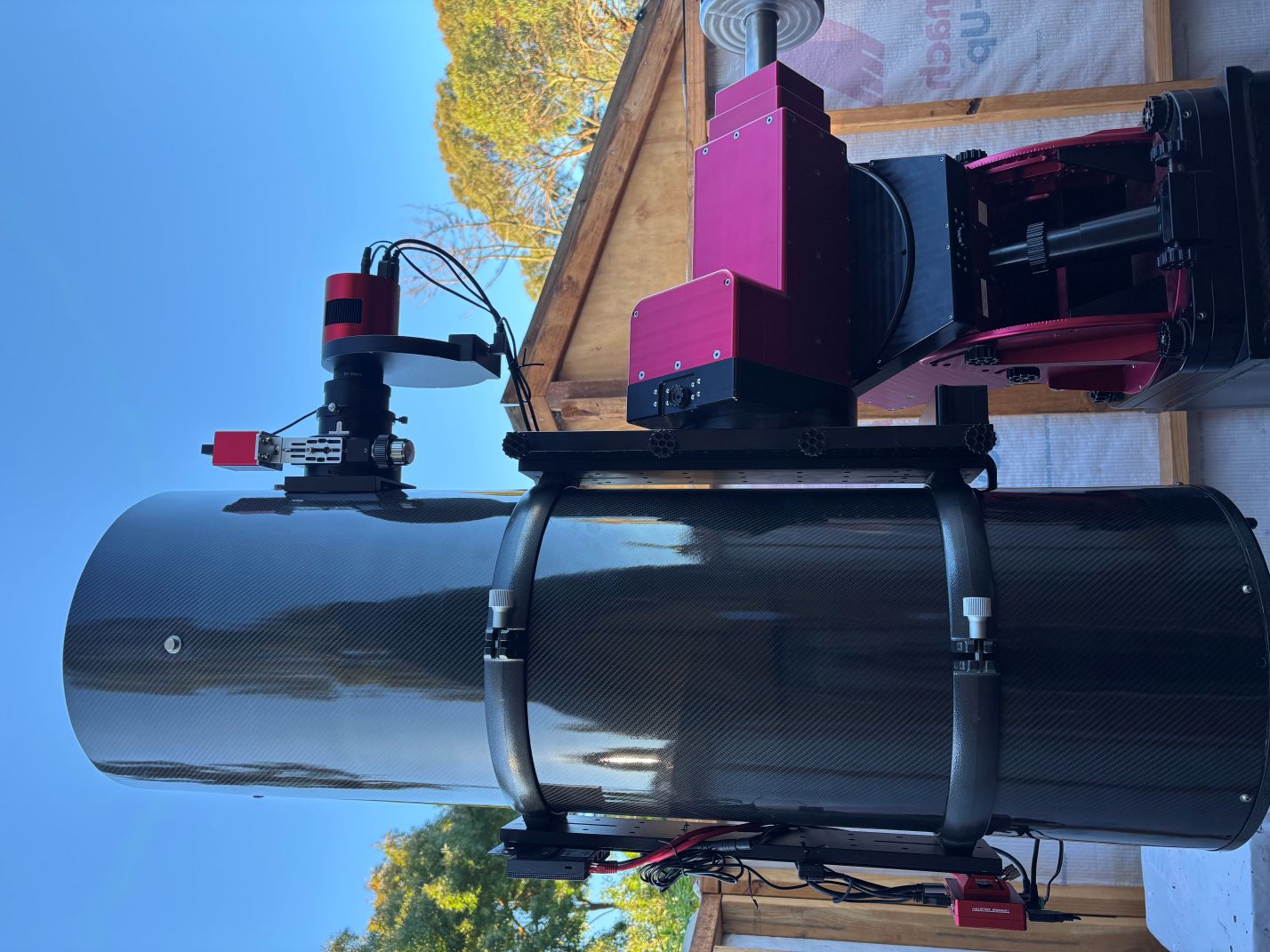Astro-Tech 12" f/4 Imaging Newtonian
Mine was branded 'Bintel' but it's the same scope manufactured by GSO and sold under different names around the world - the most common being AT12IN.
Specifications:
- Type : Newtonian
- Aperture : 304.8mm
- Focal Length : 1200mm
- F number : f/4
- Diagonal Mirror Obstruction : 87mm (29%)
Weight Breakdown:
- Rings and Dovetail 2.7 kg
- Focuser + Adaptors 1.0 kg
- Secondary & Assembly 0.6 kg
- Mirror Cell Assembly 2.1 kg
- Primary Mirror 6.3kg
- OTA 7.3 Kg
- Total approximate 20kg
Primary
The mirror is approximately 37mm thick and was already center spotted reasonably accurately. The primary mirror rests on 3 trianges that make up a 9 point cell. Only one corner of each triangle is attached to the mirror with adhesive tape. The other two corners are free to move. Each triangle is made of metal reinforced plastic and has a plastic socket moulded on the back. This socket snaps onto a ball which is attached to the cell by a captive thread. This arrangement allows the triangle to tilt and evenly distribute the weight of the mirror.
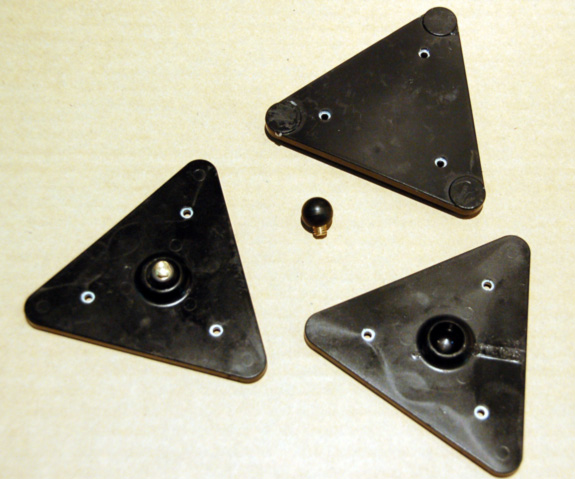
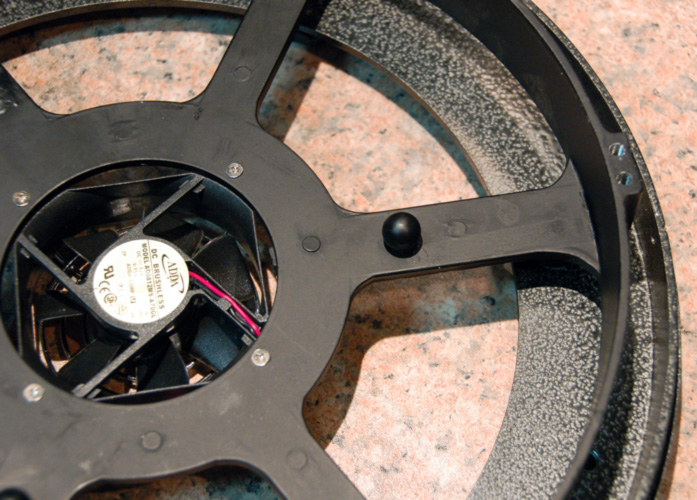
There are 3 standard GSO style rubber mirror clips. These should be checked to make sure they are not touching the mirror (I have removed them in the image below).

The cell has 3 push and 3 pull screws, and just like the AT8IN, they are spaced evenly 60 degrees apart. To me this seems a bad design - the cell can easily be bent by tightening the push screws. It won't effect the optical performance, it just make the collimation action more 'spongy' and less precise.
Finally there is a small 12V fan which blows cool air onto the mirror.
Secondary
The secondary is held in place by a GSO standard plastic holder. The four spider veins are about 1.5 mm thick and are susceptible to bending when the spider is removed from the OTA. The secondary mirror is 87 mm x 123 mm and appears to be offset by about 5 mm away from the focuser (you should be able to see the offset in the image below)
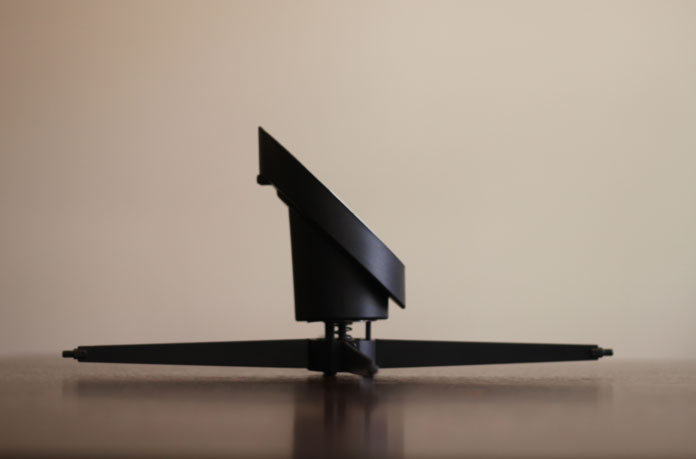
Using this calculator the required diagonal offset is 5.56mm which is within the error margin of the measured value. The secondary is undersized, and doesn't even provide 100% illumination at the centre of the image. Whilst this is not a big problem, I have replaced my secondary with a larger one (4 inch).
OTA
The OTA is constructed of 0.74 mm thick sheet steel, is 1150mm long and 357mm in diameter. The outside is powder coated white and the inside is a matt black paint. Reflections can be seen when looking down the OTA.
At night the top of the OTA is usually about 2 degrees cooler then the underside.
Just like the AT8IN, the OTA does flex around the base of the focuser. At first I reinforced it with a bar of 3mm Aluminium. The following video was made AFTER the OTA was reinforced. By hanging the camera (2.3 kg) off the focuser, and simultaneously looking through a Catseye Infinity XLK, the shift in collimation can be clearly seen by observing movement of the centre spot reflections. This is a highly sensitive test and can be used to check if the focuser or tube is sagging.
Update: I have since replaced metal OTA with a carbon fibre tube, the focuser has also been replaced and my new camera is 1.2kg lighter than the old SBIG - weighing in at only 1.1kg
Focuser
The focuser is based on a Linear bearing, this time it's a CPC MR7W (see image below). The linear bearing works well, but unfortunately it's attached to the outside of the focuser with 4 small screws spaced very close together and the surface it's attached to is curved. The result is the entire linear bearing and inner tube of the focuser has some movement in it when only a small force is applied. Tightening the 4 screws is not a solution : it causes a the linear bearing to bind.
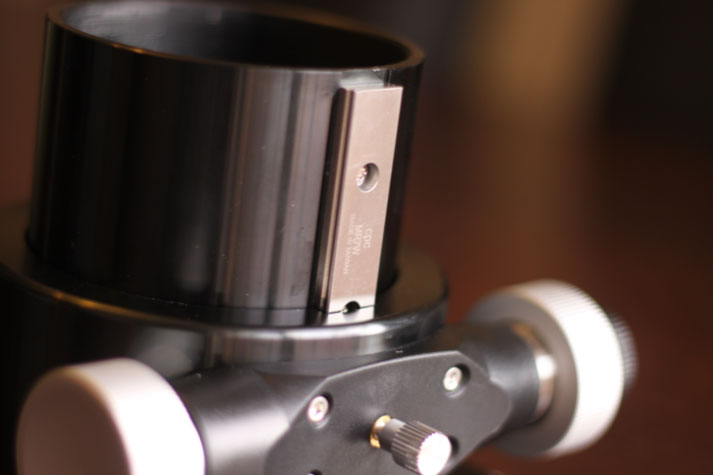
In the image above you can see the tension knob on the bottom of the focuser. It's aluminium and threads into a captive brass nut set in to a black plastic housing. There are two problems with this arrangement: the tension screw works it's way loose. A small drop of Loctite is needed. The second problem is that a lot of tension is required to hold the focuser in place with a heavy camera is being used. The plastic housing is not up to this job and ended up cracking. When the plastic cracks, the focuser is unusable. It really should be aluminium.
The focuser is supplied with a standard 2 inch to 1.25 inch adaptor. The 2 inch compression ring can be unscrewed (it has a 0.8M thread). This leaves another adaptor on the focuser that can also be unscrewed revealing a ID 3.002 inch M0.8 threaded unobstructed barrel. This allows the use a 3 inch coma corrector. Be careful when this last adaptor ring is removed (as in the image above) - there is nothing else to stop the inner tube of the focuser falling all the way back into the OTA, separating the two halves of the linear bearing and exposing all the tiny ball bearings. Getting them back in is not easy.
In the image below, I have loosened all these parts so you can see the connections.
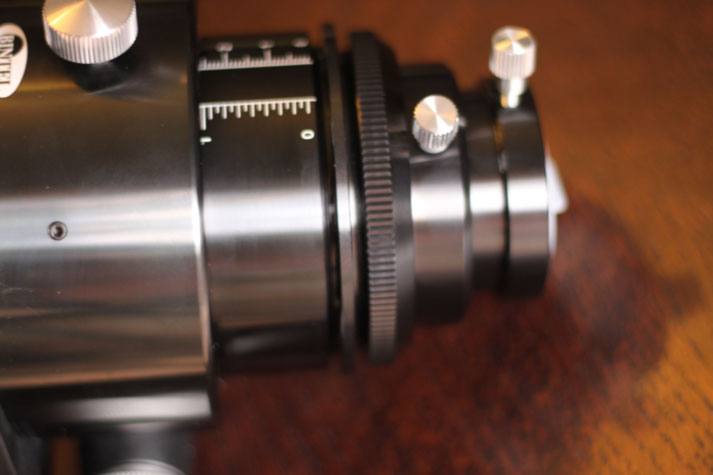
The focuser has 50mm of travel, but the last 20mm result in the focuser protruding into the OTA tube. At some point this could create diffraction interference if it enters the light path.
The focuser is held on the mounting plate by 2 small grub screws in the standard way, however loosening these only allows the focuser to be rotated, not removed. There is a flange on the underside of the focuser that prevents separating the focuser and baseplate. Extreme care should be taken when tightening these grub screws that they are located correctly on the flange. Additionally over tightening the grub screws can bend the base out of shape.

Here is a rear view showing the 2 grub screws and the linear bearing. With the Catseye Infinity XLK installed I could 'rock' the focuser on these two grub screws. I replaced these two grub screws with longer ones (they were a bit short) and added 2 more grub screws on the opposite side for 4 in total - one on each side.

Coma Corrector
I have coupled this scope with a 3" Wynne Corrector 0.95x 3KORRW from ASA. It's the prefect size to fit in the stock focuser. This annotated image shows the 3 inch coma corrector and SBIG STL Camera in place. The first test image taken with the combination can be seen here.
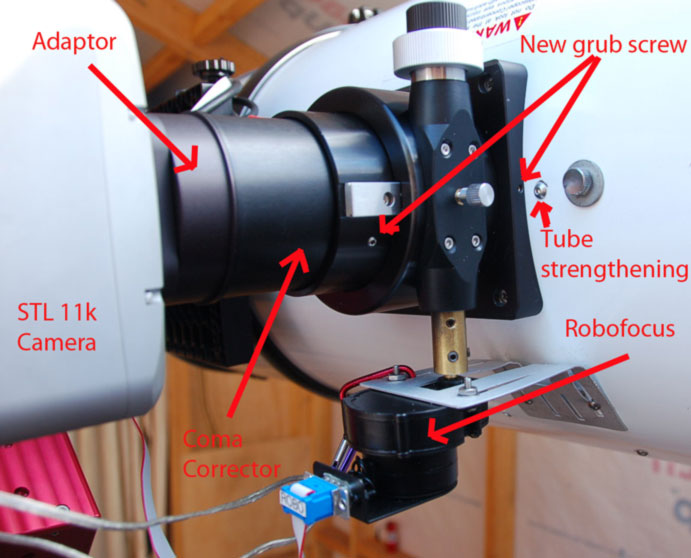
Other accessories supplied
- Small battery pack to power the fan
- Losmandy style dovetail plate (357mm long) with 4 hex nuts and Allen key. Has been replaced with a longer one from ADM.
- 2 x Rings
- Finder Scope, bracket and shoe
- 2" extension tube
- Plastic end cap
Upgrades
I have performed the following upgrades on this scope:
- Replaced the steel OTA tube with a carbon fibre tube from Klaus Helmerichs. The new tube is much stronger and has greatly reduced the movement at the base of the focuser.
- Replaced the focuser with a TS-Optics 3" UNCN3. The original focuser ended up breaking - it was not up to the job.
- Added a ZWO EAF to automate focusing
- Replaced the secondary with a larger 4" 1/30 Wave PV from Antares Optics.
- As mentioned above, added 3" Wynne Corrector 0.95x 3 KORRW from ASA.
- Replaced the dovetail with a longer one.
- Replaced the fan with a larger one.
- Change the primary mirror center spot with a Catseye yellow Hotspot.
- A custom adaptor from Joshua Bunn at Southern Cross Custom Engineering to connect the ASA Coma corrector to the ASI2600MM Camera M54 thread.
ASA Coma corrector and custom adaptor:

The scope as it now looks ready for a nights imaging on a clear night. I could not be happier with the scope and how it performs.
